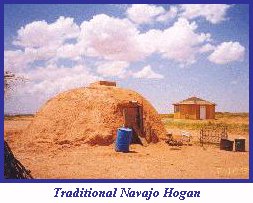
The Navajo tribe is believed to be a fusion of the Apaches and Pueblo Indians. “The Navajo believe that they were created by sacred beings and emerged from the lower worlds until reaching the fourth world in which they live today” (Winson, 2002, no page). The Apaches are Athabaskan linguistic stock who migrated down from Alaska or the Canadian Northwest territories (Iverson, 1981). They started their migration south hundreds of years ago which was believed to have been around the 1300s in large groups or in small bands. Apaches were a people who hunted, fished and lived a very nomadic lifestyle along the lakes and wood in the north. As they migrated south they brought this hunting nomadic lifestyle with them. The Navajo live in dwellings referred to as Hogan’s, similar to their Athabaskan ancestors huts in the north which were made out of birch bark, however in the south they were covered with mud.
The Navajo have a very simple name for themselves which is Dineh simply meaning people (Eck, 1998, no page). In the late 1500s the Apaches reached the southwest of the United States where they encountered the Pueblo Indians who were living in farming villages. The two tribes befriended one another and rebelled against the Spanish encroachment of their lands. Overtime the Apache Indians remained with the Pueblo tribe and soon their stories, myths and lifestyles changed as they settled into their new environment and learned from the Pueblos. As a result of the two cultures living together for centuries their cultures eventually merged, their language, local bands or governance system and hunting methods of the Apaches was preserved and the religious and spiritual life of the Pueblos was remained (Lindig, 1993). The fusion of the new distinct culture of the descendents of the Athabaskan Indians from the north and the Pueblo Indians of the southwest, are the Navajo Indians today (Lindig, 1993).
 |
| Source: http://www.swirc.org/people/northern/navajo.html |
The Pueblo component of the Navajo culture is visible in the small irrigation system and farming ways of life, however the most important component of the Navajo culture was introduction of the sheep. Many Navajo refugees had worked on Spanish ranches and when they fled they took the sheep with them. Later, many herds were stolen from other Indian tribes and the Spanish. The sheep are the life and blood and center to the Navajo culture. With the sheep the Navajo became a self-sufficient tribe, every bit of the sheep was eaten or used for clothing or bedding. “The introduction of the herding lifestyle provided the economic basis for cultural transformation from a hunter wandering society to a society of herders and farmers” (Benedek, 1993, p.63).
“The Navajo’s traditional practices were not systematized although shamanism was practiced to enlist the aid of deities in the hunt and to heal illnesses” (Lindig, 1993, p.36). The social organizations of the Navajo were orientated around a flexible bilateral kinship system which in practice, permitted the free choice of residents. “The tribe consisted of dozens of local groups each with a dozen or more intermarried extended families with customary rights to shared alienated land base” (Kelley & Francis, 1994, p.17). Clans do not exist in the Navajo tribes. Their political organizations consist simply of loosely structured bands. “The tribes are bound together politically by a network of several dozen headmen of equal status as well as by marriage between families of local groups” (Kelley & Francis, 1994, p.18). There was no institutionalized chiefdom instead temporary leaders were chosen to deal with unusual circumstances. Described by one anthropologist, “the Navajo led a wondering life, with little organized government. Their ceremonies were only a few, irregular ones which called in the wild game. Their medicine men were solidarity visionaries, with no established rituals” (Benedek, 1993, p.59).
The land and everything on it is scared to the Navajo (Kelley & Francis, 1994). The land base and families are the anchor for Navajo stories about their past. These stories cover every family’s use of land and the places the family’s have used in the past in which to earn a living. Navajo stories recognize interrelationships between man and nature by illustrating how the land and everything on it are alive, permeated by a life essence of light and moisture. Each thing in this system, including landforms, plants, animals, and natural forces has its own immortal humanlike inner form, which interacts with the other things in the system (Kelly & Francis, 1994, p.20). The Navajo do not own the land they are simply part of the system as a whole, therefore everything on the land must be respected.